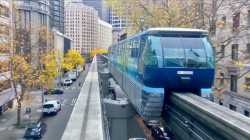>>1758880In the face of the impending loss of influence, Seifert therefore worked that
much harder against the long straightaway as a routing element. He considered
it an abomination: in his eyes, the straight Reichsautobahn route was simply
not appropriate to the landscape. The straightaway was not of the earth, but
something from outer space. Old roads with long straightaways were either “constructed along the sightlines of that age-old cultic placement that once covered
all of central Europe,” or they were un-German (volksfremd) structures imposed
from the outside. The more a road’s sinuous curves were nestled into the millennia-old bends of the landscape, the more it was in tune with the landscape,
and the smaller was the necessary excavating work and the required number of
embankments and dams. For each technical task, and thus also for the routing
of the Reichsautobahn, there was an “entirely perfect, indeed, an elegant solution” that was determined by laws. Those laws, however, could only be intuited
“in a kind of nature perception that can express itself only as a feeling.” Seifert’s
virulent antirationalism was clearly on display here. Since it was clear to him that
the design characteristics of the roads must be derived from their surrounding landscape, the option of straight roads was out of the question. Such roads were
alien to nature, an argument whose fundamentalness was beyond challenge.
(page 131-132)

